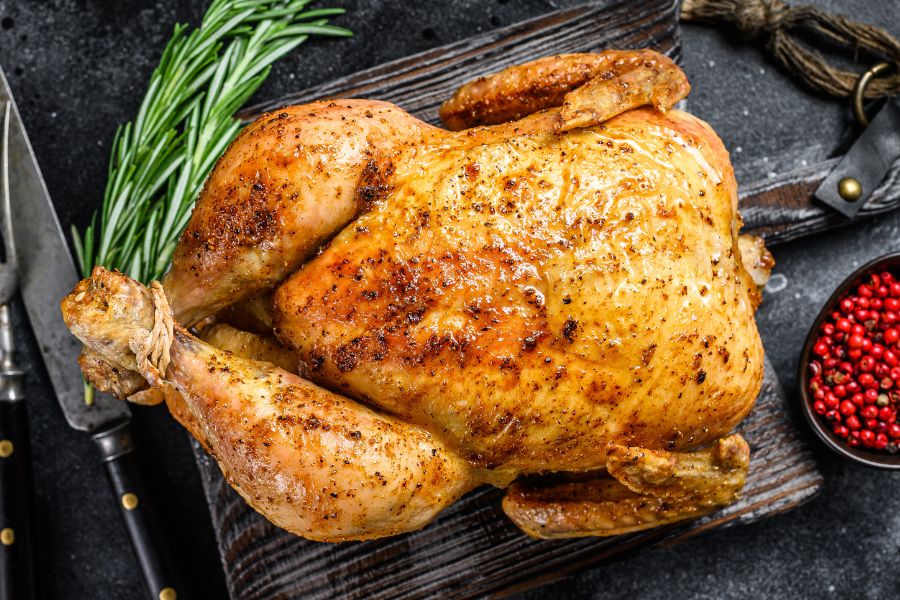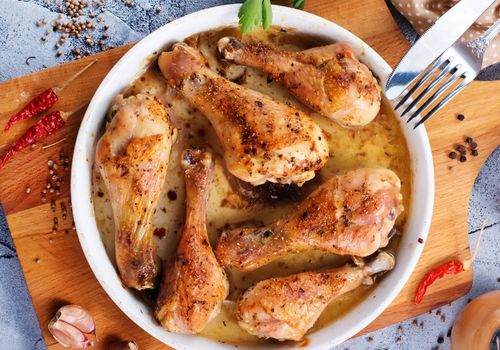Are you surprised that the chicken you put in the oven has a pink color when you carve it? Don’t be alarmed. Chicken can be a little pink and still be safe to eat.
However, this depends on the reason for the pinkness. Your bird can be a little pink if it was frozen, smoked, or undercooked.
Many pit masters, including myself, have experienced this strange hue on our tasty bird. Over the years, I’ve come up with a few ways to tell if this pink color is something to be worried or not.
So, today, I’ll pour all my experience into this article and explain the reasons why this meat can be pink. Let’s get started.

There are a few reasons that can cause cooked meat to look pink. These factors can give the impression that the meat is undercooked. However, this isn’t always the case. Here are a few reasons why your chicken could be a little pink.
When chicken is frozen, myoglobin may seep into the flesh from the bone marrow. This protein may turn brownish or pinkish around the bones after cooking, giving the impression that the meat is undercooked even when it is a fully cooked chicken.
When chicken is smoked, the smoke gives the meat a pinkish tinge. The pink color can be found below the meat’s surface, or you can see it all over the flesh of the chicken.
While chicken exposed to true smoke will have dark pink color around the outside of the meat, if the poultry has been injected with liquid smoke for a smokier taste, you may see a pink tinge on the meat.
The last reason your meat may appear pink is because it is undercooked. There will be instances where the chicken meat is pink because it hasn’t finished cooking. Undercooked chicken will have an internal temperature way below the recommended 165 degrees Fahrenheit.
If your chicken is undercooked, put it back in the oven and cook it for longer. Remember to keep a meat thermometer close to gauge the meat’s internal temperature at intervals.
Related Reading
Pink chicken is safe to eat as long as it cooks to the recommended internal temperature. Chicken that looks pink may not be appealing, but this doesn’t always mean it is undercooked.
The best sign that a chicken is fully cooked is its temperature. According to the USDA, chicken is safe to consume if the internal temperature reads 165° Fahrenheit.
Simply put, eating undercooked chicken is not safe. You risk contracting food poisoning if the chicken isn’t properly cooked, so it’s crucial to watch that it reaches the right temperature.
Food poisoning is never fun, and in the worst-case scenario, it can be fatal. According to the CDC, approximately one in six Americans contracts a foodborne illness each year, with around 3,000 people dying as a result.
It goes without saying that you don’t want to spend days in the hospital treating food poisoning, so ensure your chicken is cooked properly.

Over the years, it has become ingrained in our minds that pink chicken is undercooked. However, this is not always the case. Here, we’ll look at ways to avoid having pink chicken.
Keep in mind that slices of meat should only be returned to the oven for a limited period after being carved if there’s a faint pink color. Cooking chicken for longer will remove the pink appearance and give you the desired whitish color.
Just be careful to heat it long enough till it is no longer pink; otherwise, you’ll be left with overcooked chicken, which tastes dry without the chicken’s juices.
Remember, cooking chicken to 165°F will ensure that you always get juicy, delectable chicken. You won’t have to eat dry, flavorless meat again, and you can stop worrying when you notice a faint pink blush on your meat once you cook it to 165 degrees.
Most of the pink color in the meat originates from the area around the bones. A simple trick to reduce the chances of having pink meat is to buy and cook boneless chicken.
This way, the myoglobin protein that contributes to the meat’s pinkness will be absent. I recommend purchasing boneless chicken thighs or getting your butcher to help you debone the bird.
A food thermometer is the most accurate instrument to use when gauging the temperature of chicken.
An instant-read thermometer or digital thermometer are both excellent. Ensure the thermometer registers 165°F when inserted into the thickest area of the thigh before pulling the meat out of the cooking chamber.
You can let your cooked chicken rest for a few minutes before serving. However, make sure you don’t let it rest for too long. Cooked chicken can become tough and dry when it’s rested for too long.
The ideal method for cooking raw chicken is to cook it completely through, let it rest for about five minutes, and then serve. The meat will be juicy and tender.
Dark meat and white meat can both appear pinkish when done. White meat includes parts like chicken breast, and wings. Dark meat, on the other hand, is found on chicken thighs. Even though white meat has less red fibers than dark meat, it can still appear pink when pulled out of the oven.

Ultimately, even if your chicken is a little pink inside, it’s safe to eat if it has been cooked to the correct temperature of 165°F. Remember, your meat may appear pink because of the cooking method, frozen chicken, or because it is undercooked.
Undercooking is one of the most dangerous threat to your gastric health, so use a meat thermometer to check the temperature of the meat and eliminate the possibility that it is undercooked. Once you’re sure the meat is not undercooked and safe to eat, you can savor this delicious protein as you wish.